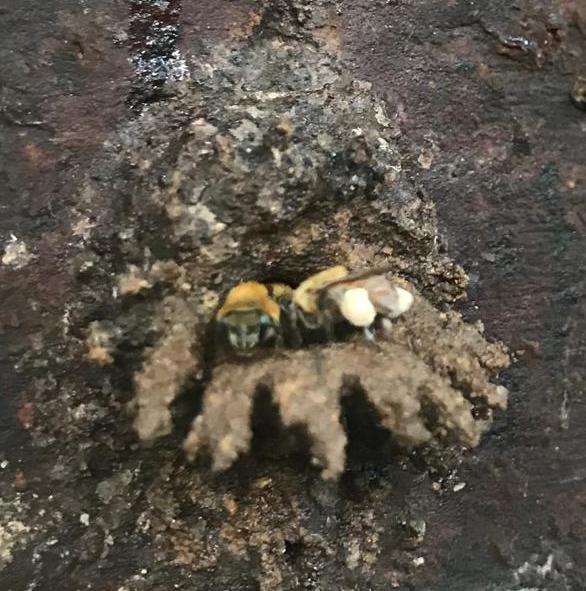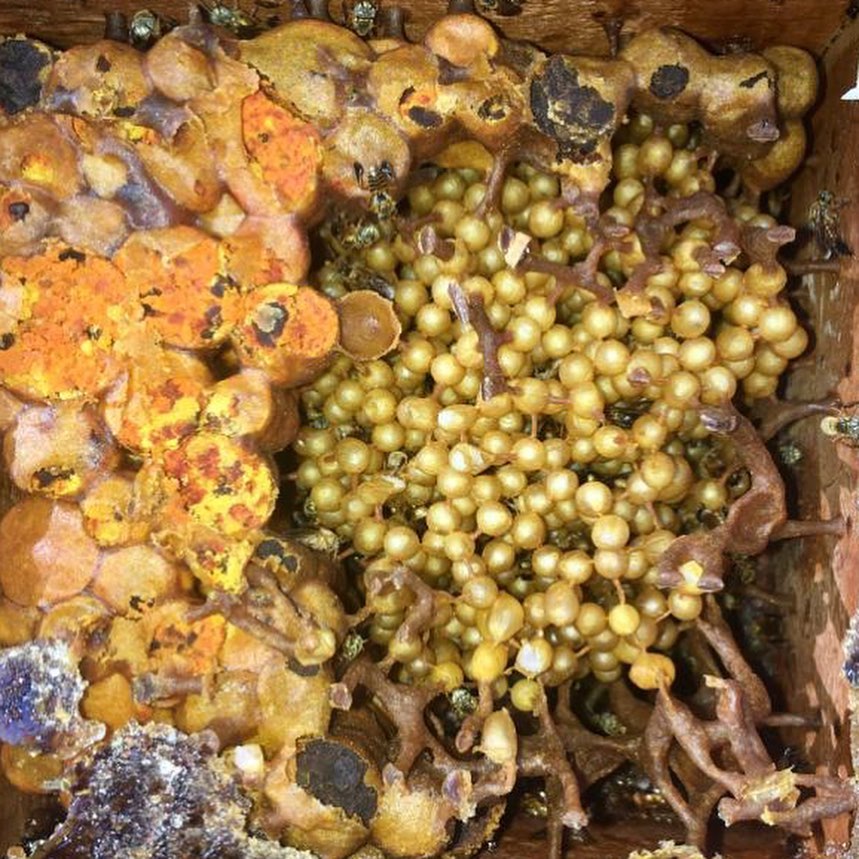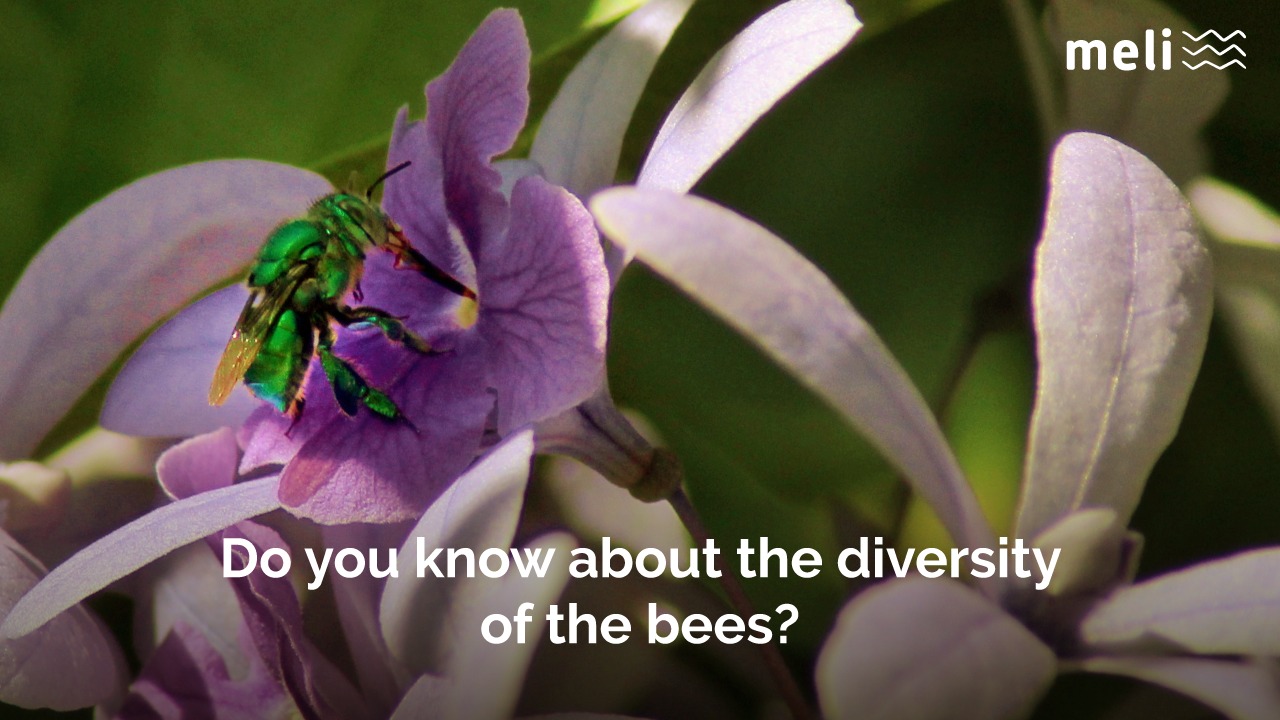Author: Patrícia Nunes-Silva
Auf deutsch lesen. Leia em português.
Not everyone knows that there are thousands of other bee species besides the black and yellow striped bee, the honey bee Apis mellifera. Fewer people know that this bee is not native to Brazil and was introduced to the country during its colonisation. So how many species are there in the world? We know about 18,000, and it is estimated that there are about 20,000 in total, of which 1600 occur in Brazil.
Another fact that is also not well known is that most bees are not social. These species are called solitary bees and the females live alone, doing all the work to build their nest. When this female finishes building her nest she either leaves to build another one or dies before her children emerge from her brood cells. The only social interaction between adults is during mating. It is important to mention that there are not only solitary and social species, but there is a social gradient, with communal species, for instance, whose females share the same nest, but each takes care of its own brood cells. Or quasisocial species, which besides sharing the nest, cooperate in the care of their offspring, e.g. collectively take care of their young. In addition to the great diversity in the number of species, there is a great diversity of behaviour.

Only about 15% of species are social, i.e. they have overlapping generations, cooperative care of offspring, and division of reproductive labour. This means that social bees live in colonies composed of individuals of different ages and the individuals (workers) care collaboratively for the brood. Furthermore, there is only one female which is able to reproduce in these colonies, the reproductive caste which is known as the queen. The workers generally do not reproduce and are responsible for all the work that allows the colony to exist.
The bees are divided between families and the number of existing families varies according to the taxonomist (researcher who classifies the species). There are five families of bees in Brazil: Andrenidae, Apidae, Colletidae, Halictidae, and Megachilidae. As well as the diversity of social behaviour, the diversity of sizes and colours and lifestyles is enormous as well. The bees best known to people belong to the Apidae family, such as the honeybee (A. mellifera), the carpenter bees or mamangavas (Xylocopa spp.), and the bumblebees (Bombus spp.), although people often think that mamangavas are from another orders of insects, such as Coleoptera (beetles).

Among the social bees that occur in Brazil are the bees of the Meliponini tribe (meliponini), known as stingless bees. These bees occur in the tropical and subtropical regions of the world. We know about 500 species of stingless bees on the planet and it is estimated that there are at least 100 more that have not yet been described. Brazil has a great diversity of meliponini, where 244 species occur, of which about 89 remain undescribed. Of these species, 87 are endemic, i.e. they occur only in the country and correspond to 20% of the diversity of Neotropical stingless bees. Furthermore, two genera, Friesella and Trichotrigona, have only been registered in Brazil.
It is important to note that, unlike A. mellifera, stingless bees are native to Brazil. They are a treasure trove of diversity of colours, sizes, shapes, behaviours, ways of life, nest structures, and associations with other organisms, let alone the variety of types of honey, pollen, and propolis that these species produce. Not to mention the diversity of plants that these species visit and pollinate, making plants thrive and produce food for other animals, like us humans. This is the potential of meliponiculture, the rational keeping of meliponini. Protect our diversity of bees, protect our stingless bees!

References:
Michener, C. D. (2000). The bees of the world. The Johns Hopkins University Press; Baltimore, USA and London, UK. 913 pp.
Michener, C. D. (2013). The meliponini. In: Vit, P., Pedro, S. R., & Roubik, D. (Eds.). Pot-honey. Pot-honey: a legacy of stingless bees. Springer, New York, NY. pp. 3-17.
Pedro, S. R. (2014). The stingless bee fauna in Brazil (Hymenoptera: Apidae). Sociobiology, 61(4), 348-354.
Silveira, F. A., Melo, G. A., & Almeida, E. A. (2002). Abelhas brasileiras. Sistemática e Identificação. Fundação Araucária, Belo Horizonte. 253 pp.
Your donation can impact the world positively!
Subscribe to receive our Newsletter!
Find us also at Linkedin, Facebook, Twitter
or Instagram
www.meli-bees.org
❤️


2 Replies to “Do you know about the diversity of bees?”